








After 51 years, the victim-centered program enters its final days at Iowa.
Jack Moore Managing News Editor jack.moore@dailyiowan.com
Editor’s note: This article contains mentions of sexual violence.
Starting as a hotline for women in crisis over 50 years ago and evolving into a leading program for sexual assault victims in Iowa, the Rape Victim Advocacy Program — also known as RVAP — at the University of Iowa is now facing its final days of operation.
Five months ago, the UI announced it would transition all RVAP’s services by Sept. 30 to the Iowa City community nonprofit Domestic Violence Intervention Program, also known as DVIP, and layoffs would follow.
The news stunned students, resulting in protests across campus over the following weeks. Those who were most surprised, though, were RVAP’s own employees.
Staff told The Daily Iowan in April that many of them learned of their impending dismissals through news outlets and a campuswide email informing the public of the changes. In its announcement, the university cited RVAP’s low rate of helping survivors on the UI’s campus. The vast majority of their clientele, according to the UI, came from outside the university community, in the eight counties — including Johnson — that RVAP serves.
The university argued that for RVAP to expand and thrive, it would be best for the organization to leave the university.
The decision left a glaring question: How, in five months, was DVIP supposed to take on the multitude of services offered by RVAP?
Ultimately, a combination of ensuring funding and establishing DVIP as a resource for sexual assault survivors would become their biggest hurdles. DVIP is now taking those head on.
The

“Everybody
Johnson
Director
the
in a work session Wednesday morning to review proposals for the building.
“We’re all aware that the building’s lived its life, and that’s putting it gently,” he said before beginning his summary.
In his report, Curtis mentioned the roof leaking every time it rains, the air conditioning units being well past life expectancy, and exterior brickwork appearing to be failing.
The county received requests for proposals from three architecture and engineering firms: Axiom Consultants, Shive-Hattery, and Vantage Architects, Curtis said.
Curtis recommended the county continue to work with Axiom, an engineering consulting firm that completed a structural property condition assessment in 2023 and did ongoing monitoring of the structure in May 2024. The report states Axiom’s proposal is the most realistic for the county to follow.
According to Curtis’ report, there is $300,000
ran, I was appointed.” Persons said she finds fulfillment in her work in local government, and her new position has broadened her understanding of the role officials play in small communities.

Julie Persons is set to become the new Johnson County auditor after she was selected on Aug. 24 as the Democratic Party’s nominee. She will be the first woman to tackle the role in 48 years.
Persons is the current mayor of Swisher, a tiny town with a population just cresting 900. She took office as mayor in January and less than a year later was nominated to become the county’s auditor during a four-candidate convention.
She became mayor after Swisher’s previous mayor retired and no other candidates stepped forward.
“I had already been working for the city and knew the council and the previous mayor, so we went through the appointment process,” Persons said. “Rather than being elected because nobody
“I didn’t realize that you do a lot more than just running the council meetings and signing
“It runs the entire gamut, but things that happen in a small town, probably the mayor is going to have to be directly involved.”
Julie Persons Mayor of Swisher
the checks and ordinances,” Persons said. “It runs the entire gamut, but things that happen in a small town, probably the mayor is going to have
to be directly involved.”
The Johnson County auditor’s position became vacant after long-time auditor Travis Weipert resigned on July 26, citing personal health concerns. Weipert had served as the county auditor for over a decade. His resignation prompted the convention, which later led to Persons’ nomination. In the meantime, the Johnson County Board of Supervisors appointed Erin Shane, the county’s deputy auditor, to serve for the remainder of Weipert’s term.
The August convention drew four candidates: Alex Stanton, Shannon Patrick, Newman Abuissa, and Persons, The Cedar Rapids Gazette reported.
John Deeth, caucus convention chair for the Johnson County Democratic Party, told The Daily Iowan that this is an unusually high number of candidates for such a position.
“I don’t think we’ve ever had a convention with
The organization is recruiting staff and finalizing agreements with the UI this week. Now, with the transfer just days away, DVIP is set to continue a legacy that has been in the making for over 50 years. .
Why did the UI decide to cut RVAP?
Vice President for Student Life Sarah Hansen said the transition of resources from RVAP to DVIP would enable RVAP to grow its services. In a press release sent out in April, the university cited that about 12 percent of direct services and only 7 percent of crisis calls were used by or from UI-affiliated individuals.
DVIP has 33 staff members that cover its service area, while RVAP had just 12, with an additional seven who worked the phones overnight. Chris Brewer, the UI public relations manager, said in April that six of RVAP’s staff would be laid off by the closure, two had been previously notified of layoffs, and four of the employees’ contracts expired on June 30.
Hansen told the DI in April that RVAP’s role at the university was something they had been discussing for nearly 25 years.
Even Hansen admitted that the communication to RVAP’s staff was rushed. She said that information about the transition was spreading, and it led the UI to move quickly.
“We had some folks who communicated — I think inappropriately — about what was going to happen, and we were really worried about the staff hearing from people other than us,” Hansen said in April.
How is the transition going?
Several concerns perforated the community about the transition, including whether DVIP had enough resources, how survivors would find their services, and whether DVIP was an established enough resource known throughout the area.
So far, DVIP has held several initiatives to overcome these challenges — but it is coming down to the wire. With only the remainder of September until they are expected to take on all services, there is still no formal agreement between DVIP and the university for them to take over.
However, Hansen and DVIP’s Director of Community Engagement Alta Medea said that a written agreement between the university and DVIP was being finalized this week.
Over June and July, DVIP assembled a Sexual Assault Victim Services Advisory Council which met to discuss what services they wanted to continue into DVIP, Medea said. They also created working groups in each of the eight counties to work with individuals through the transition.
In April, DVIP’s director said they would hire 10-15 new staff members to take over the services. In a recent interview with the DI, DVIP’s Medea said they have hired nine out of 10 open positions as of Sept. 12.
Two advocates will be housed at WRAC, Medea and WRAC’s Director Linda Kroon said. The university is also adding another educational staff member to WRAC, Hansen said. Hansen also said the university would be committing around $125,000 to DVIP for the advocates at WRAC. Medea said no employ-
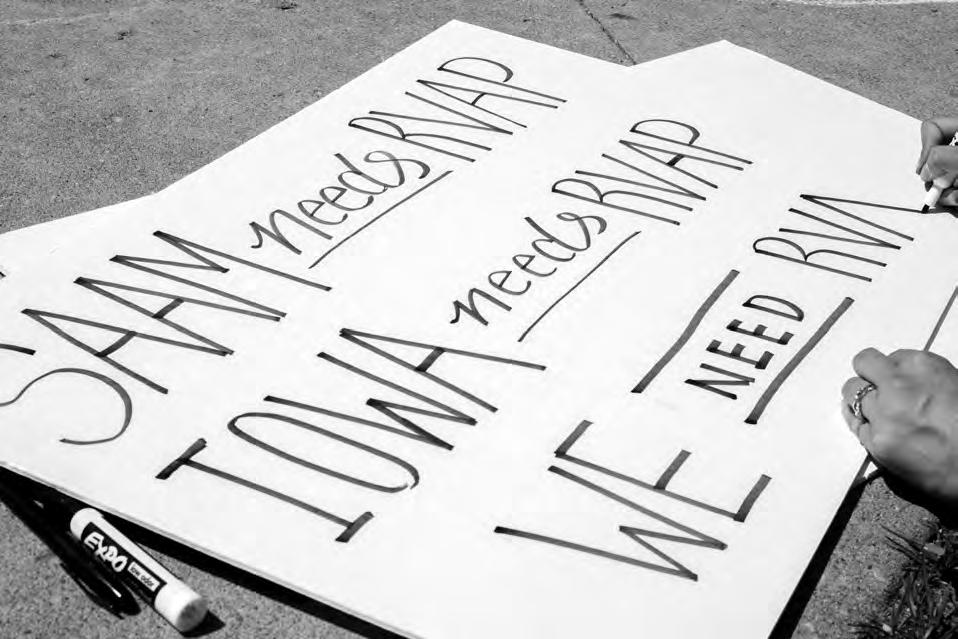
ees from RVAP applied for positions at DVIP.
To provide a seamless transition, Medea said they have rebranded DVIP to include RVAP’s name, and they are continuing the same crisis line for 18-24 months. On Aug. 21, they sent an open letter to RVAP’s clients to help them with the transition.
They also hired a new director for the sexual assault services, Shell Feijo, on July 17. Feijo has worked with sexual assault survivors and the university in the past.
future.
At the end of July, Iowa Gov. Kim Reynolds announced that Iowa would use $5.5 million from the American Rescue Plan Act this year for “one time bridge funding” of victim services.
For DVIP, this meant they would have the funding they needed to transition RVAP and finish initiatives such as a new emergency shelter, which increases the number of beds they offer by 30.
believe the university is making the wrong decision by moving the program.
“I am still of the belief that you need to have two separate funding services for sexual assault and domestic violence,” Brown said. “They need two very different resource amounts, and they need different resources.”
working on its anti-violence plan, training staff, and seeking out new innovations. She said the UI also recently joined a study conducted by the University of Washington that is working on an application that helps survivors of sexual violence.
“She has a wide range of experience both on college campuses as well as working directly with victim survivors,” Medea said. “We are extremely excited to have her in this position, and [it] has been incredibly helpful to have her expertise while we’re writing some of these grants to fund sexual assault services.”
“I believe that DVIP has a fair shot of doing great things, good things for the people that need it.”
Gail Osborn A sexual assault survivor from rural Washington County
Medea said DVIP would serve both survivors of domestic violence and sexual violence. DVIP also has two transition shelters that are used to get people back on their feet. However, supplemental ARPA funding is not guaranteed past this year, and no one is entirely sure how much funding they will get next year.
Medea said they will continue fundraising to help meet their needs.
Additionally, Medea said they are working to begin dual training for their advocates so that as they work with survivors of sexual assault, they will have full support. She also said they are testing the phone lines this week to make sure there is a seamless transition for the crisis line.
As of Sept. 16, RVAP’s website says that due to the upcoming transition, all their current services have decreased. However, Hansen said they have hired more than 30 temporary staff to ensure the hotline is always operational.
Brewer told the DI in April that RVAP operated off a $1.1 million budget, and they said they were committing their funding to DVIP. However, the university only funds 20 percent of that amount.
Most of RVAP’s budget came from grants allocated through the Office of the Attorney General of Iowa alongside grants and state funding.
Nearly $700 million is being cut this year in funding to the Victims of Crime Act, or VOCA, which funds victim crime services across the country. Medea said that victim services are feeling that cut this year but is hopeful that there will be more money available in the
When the UI first announced RVAP was closing, over 80 people gathered at the UI Pentacrest to protest the university for its decision. A couple weeks later, students again protested by demonstrating a sit-in outside Hansen’s office.
On April 26, the UI Council on the Status of Women, which works to build environments that support women’s rights, wrote an open letter to Hansen that criticized the decision to close RVAP.
“We are concerned about the lack of transparency in the decision to dissolve the Rape Victim Advocacy Program at The University of Iowa,” the letter read. “This lack of transparency and learning about the decision from a campus-wide email undoubtedly negatively affected RVAP clients and our students going through a Title IX or criminal investigation.”
The group also expressed concerns about what access would look like for students following the transition.
Olivia Brown works as a student on-call direct service advocate at RVAP and helped organize the protests in the spring. In a recent interview with the DI , Brown said they still
Gail Osborn, a sexual assault survivor from rural Washington County, said in a recent interview that advocates from RVAP helped her at a critical point in her life. She said DVIP has big shoes to fill to reach the level of trust RVAP had in the community.
“I believe that DVIP has a fair shot of doing great things, good things for the people that need it,” Osborn said.
She said it will be important for DVIP’s staff to develop the community’s trust after the transition happens.
Sofia Day, a third-year student at the UI, said she first contacted RVAP when she was a freshman. She said that she was raped while on campus and RVAP’s advocates were people she could turn to in that moment.
She said advocates from RVAP helped her through that period, and she said even if there are still advocates on campus, it will not be the same.
“I think there are a lot of victims who need to tell their stories, and also a lot of them who are not ready to tell their stories,” Day said. “I think only having two [sexual assault advocates] on campus that they can go to limits how fast they can heal.
Hansen said she thinks the campus will see the same level of attention from staff compared to RVAP. She said the two advocates serve as experts in a college campus setting.
What’s next
Looking forward, Medea said RVAP’s crisis line is being maintained, staff is being hired, and programs are being continued. Whether these promises will be fulfilled in the future is yet to be seen. Medea said they are confident they will continue serving the university and the eight counties RVAP served.
Hansen said the university plans to continue


“We’ll continue to work on our anti violence plan, which is a cross institutional plan that looks at intervention as well as the prevention components of this,” Hansen said. “So things like adding staff, making sure that that our students are getting trained, that faculty and staff are getting trained on what is appropriate and inappropriate behavior across the whole range of things, from sexual harassment, to sexual assault, to stalking, to dating violence.”
While the UI has reported decreases in sex-related crimes on campus, this first few months of the fall semester has the most demand for sexual assault advocates, WRAC’s Director Kroon said. Kroon said this time period is called “the red zone,” and she said staff are keeping up so far.
According to the UI’s crime report from 202223, 13 rapes were reported on campus in 2022. This number is down from 54 in 2021.
Reports of fondling were also down from 27 to 18.
According to the UI’s most recent Speak Out Iowa Survey from 2021, 16.6 of female students, 5.1 percent of male students, and 22.6 percent of transgender or gender non-conforming students have experienced a rape or an attempted rape in their life.
The Centers for Disease Control and Prevention reported over half of women and one third of men have experienced sexual violence in the U.S.
Medea said DVIP plans to build trust in the community through hard work.
“I think that trust is built through work, right? Like any type of relationship, trust is built on the way that you show up, and we have shown up for 45 years,” Medea said. “For victim survivors of intimate partner violence, I think continually centering victims to voices and decision making helps lead to that trust building.”

Asst.
Opinions Editor Carson Hartzog carson.hartzog@dailyiowan.com
Visuals Editor Isabella Tisdale isabella.tisdale@dailyiowan.com
Asst. Visuals Editor Emma Calbaro emma.calbaro@dailyiowan.com
Digital Editor Riley Dunn riley.dunn@dailyiowan.com
Audience Editor Shreya Reddy shreya.reddy@dailyiowan.com
DITV News Director Johnny Valtman johnny.valtman@dailyiowan.com
DITV Asst. News Director Jayce Bertrand jayce.bertrand@dailyiowan.com
DITV Sports Director AJ Reisetter aj.reisetter@dailyiowan.com
DITV Asst. Sports Director Brady Behrend brady.behrend@dailyiowan.com
DITV Tech Director Madison Johnson madison.johnson@dailyiowan.com
BUSINESS STAFF
Business Manager Debra Plath debra.plath@dailyiowan.com 319-335-5786
Advertising Director/ Circulation Manager Juli Krause juli.krause@dailyiowan.com


budgeted for jail construction, which would more than cover the approximately $36,500 project needed for basic repairs. The cost is subject to change based on Axiom’s initial investigations.
The final Johnson County Jail and Sheriff’s Office needs assessment report, a $75,000 study conducted by Shive-Hattery, was presented to the Board of Supervisors in a work session on July 10.
According to the report, the current design is operationally inefficient. The facility was constructed in 1981 and was designed for 46 inmates and 50 staff. However, over 100 people currently work in the building, Kunkel said.
The report addressed several other concerns in the building, including toilets, door swings, and turn swings not complying with ADA guidelines. Inmate intake, processing, visitations, and food services are all located on the second floor, which was flagged as problematic.
According to the report, the Johnson County Jail has been operating above functional capacity for over a decade. Johnson County has spent nearly $16 million since 2003 to house its overflow of inmates in other nearby county jails.
The needs assessment found keeping up with current inmate trends in Johnson County would require an estimated increased need of three beds per year. If the county were to go forward with the project laid out by Shive-Hattery, the new jail would have 140 beds and meet the needs of the county for a minimum of 20 years.
Shive-Hattery estimated a maximum cost of just over $83 million for a new jail and sheriff’s office in the report, should the county choose to proceed. The other option outlined in the report is to forgo building a jail and only proceed with a sheriff’s office and temporary holding facility.
Kunkel voiced his concerns in the July 10 work session, stating that doing nothing would be ineffective, as the county will always need a place for booking, intake, court holdovers, and releases.
“We would still be building, in effect, a jail anyway,” Kunkel said in the meeting.
“We would have to staff it, and we would still need a place for the sheriff’s office and everything else that we do.”
Supervisor Lisa Green-Douglass voiced during the meeting that she would like to see the county move forward with the project and offer spaces for healing within the new jail.
As a previous board member for Iowa’s 6th Judicial District, Green-Douglass said she saw the recidivism rate — or the rate at which people who are convicted of a crime commit an offense after being released — fall to three percent. Green-Douglass said that is one of the best rates in the country and believed it was due to community-based programs.
“If you have places where people can consult with their counsel, their family, education courses, trainings — then you can to that point whereupon release you’ve got a lot more ability for reentry,” Green-Douglass said in the meeting.
Supervisor V Fixmer-Oraiz addressed other worries during the meeting, saying they would rather see money from the project go toward rehabilitation programs.
“We know that jails interrupt families, destroy people’s careers. There’s nothing rehabilitative about a jail,” Fixmer-Oraiz said during the meeting. “You cannot give somebody care in a jail. You just fundamentally cannot. The idea that we would even expand mental healthcare in the jail is absurd to me.”
Aside from the approximate $80 million for the cost of the building, the rest of the money would be invested in the land, personnel, and other general upkeep items, totaling an approximately $800 million over the course of 20 years.
Fixmer-Oraiz said they would prefer the money go toward something like affordable housing across the county.
No plans have been solidified concerning the next steps for the jail, but more loose ends will be tied up in the Sept. 18 work session, Kunkel said.

from 1A
four candidates,” Deeth said. “We’ve had one where we went to a second ballot, but Julie received just over a majority on the first.”
To secure the party’s nomination, a candidate needed 57 votes — a majority of the 113 county Democratic delegates present at the convention. Persons received 60 votes.
The auditor for Johnson County oversees the administration of local, state, and federal elections, ensuring that voting processes run smoothly and accurately. The Auditor’s office also maintains voter registration records, handles property ownership records for tax purposes, and manages the county’s accounts payable and payroll functions.
As mayor of Swisher, Persons said she’s gained experience in managing municipal


budgets, facilitating public meetings, and working closely with city residents.
“I wish I had known what local government was like when I was younger,” she said. “You can see tangible results from the work done at the city and county levels.”
Ed Cranston, chair of the Johnson County Democratic Party, said he is enthusiastic about Persons’ nomination.
“I think she’ll be just a wonderful auditor,” Cranston said. “Looking at her background, she’s had leadership roles that would be similar to what she would be doing there in the auditor’s office.”
Cranston also praised Persons’ commitment to transparency in her role as mayor.
“Folks in Johnson County will know what’s going on there in the auditor’s office,” Cranston said.




Iowa Gov. Kim Reynolds submitted a waiver to opt out of a federal food program.

Roxy Ekberg Politics Editor roxy.ekberg@dailyiowan.com
During the first week of summer break in Lisbon, Iowa, school-aged kids popped into the Southeast Linn Community Center to ask if the center had food. Executive Director Nicole McAlexander said a scene like that had never happened before.
Lisbon is one of many rural communities that did not receive a summer meal site after Iowa Gov. Kim Reynolds’ administration did not submit a request to join a new federal program aimed at providing direct food aid to families during summer break. Rather, Reynolds’ administration started an initiative to expand the state’s summer lunch program.
SUN Bucks, also known as Summer Electronic Benefit Transfer or Summer EBT, provides eligible families $120 per child per month on an EBT card — which functions like a credit card — to spend on groceries.
Reynolds submitted a waiver on Aug. 15 to opt out of the federal meal program and instead use the money to provide boxes of food to be picked up at participating sites around the state.
The program is paid for with federal dollars and would have cost the state the money it takes to administer the program — roughly $2.2 million. The state could have received up to $29.4 million in federal funds for the program.
Reynolds said in a December news release that an EBT card does not promote nutrition at a time when childhood obesity is on the rise. However, USDA research found that summer EBT programs reduce child hunger and support healthier diets in pilot programs.
This past summer was the first year EBT has been offered at the national level. Iowa families who typically receive free or reduced-price school meals during the school year would have qualified for the program.
Instead of the SUN Bucks program, Reynolds distributed $900,000 in competitive grants that allocated money to local groups to provide summer meals to kids across the state.
Awarded to school districts and other qualified organizations, the program launched additional summer meal sites utilizing two existing federal programs: the Summer Food Service Program and the Seamless Summer Option.
The governor’s program created 61 new meal sites for a total of over 500 sites in Iowa, according to an August news release from the governor. However, McAlexander and other local food pantry leaders say this program is not enough to serve the state and that the lack of a summer EBT program has worsened Iowa’s food insecurity.
McAlexander said the loss of Summer EBT or a summer meal site in her community created a gap for families who cannot drive to summer meal sites in Cedar Rapids or Iowa City. Those facing food insecurity in McAlexander’s area have relied heavily on the center to meet their needs — a trend seen at community centers and food pantries across the state.
The Lisbon center’s food distribution increased from 4,000 pounds in July 2023 to 5,232 pounds one year later. She said overall costs for stocking the pantry have doubled within the last two years.
Similarly, food pantries across the states are reporting an influx of need with rising numbers of community members both experiencing food insecurity and seeking assistance.
Nearly 111,000 children in Iowa — roughly 15 percent of the state’s youth — were classified as food insecure in 2022, according to the most recent data from Feeding America.
Michelle Book, president and CEO of the Food Bank of Iowa, attributed the rise in need during summer months to the fact that 42 percent of all Iowa families qualify for free or reduced lunch, and therefore qualify for Summer EBT. These families no
longer received 10 to 15 meals every week at school this summer.
“Those families, they’re going to pantries or going to meal sites, and sometimes they’re just doing without because they have not had the assistance this summer to help them fill that meal gap that their kids are missing from not being in school,” Book said.
The Summer EBT program would have aided roughly 245,000 Iowa families in securing food for children over the summer, according to the Iowa Hunger Coalition. Reynolds projects her demonstration feeding project would aid nearly 300,000 Iowa families.
Local food pantries and community centers point to the lack of a Summer EBT program as the main influence for rising needs during the summer months. Increased prices, stagnating wages, and the
The Coralville Community Food Pantry experienced a 24 percent increase in pounds of distributed food within the past year, jumping from 804,589 pounds to 997,790 pounds, according to Executive Director John Boller.
Boller said the pantry consistently stocks its inventory, but popular items such as fresh produce and milk are hard to keep in stock due to growing demand.
“There’s really no such thing as a slow day anymore,” Boller said. “At the beginning of the shift, our shelves and coolers are well stocked. Sometimes, within an hour or so, it’s looking a little more bare.”
The pantry is in its second summer providing a summer lunch program. In 2023, the pantry provided over 1,600 meals, and this year the number was closer to 2,500 meals. The pantry’s summer meal
“There were some new meal sites established in some communities in the state, but they did not reach every community, and the EBT would reach every household directly. It shouldn’t matter if a kid lives in a small community or an urban area. If they’re hungry we should find a way to feed them.”
Nicole McAlexander Executive Director of the
Community Center
Southeast Linn
expiration of pandemic benefits are other factors that play into rising food insecurity.
In the nearly 50 years of operation for the Des Moines Area Religious Council Food Pantry network, which manages 14 partner food pantry sites, this July was the busiest month on record.
That month, the network assisted 28,000 people, according to Blake Willadsen, Des Moines Area Religious Council Food Pantry marketing and communications manager.
Willadsen recorded in July that about 36 percent — or roughly 10,000 people — who utilized a Des Moines Area Religious Council Food Pantry Food Pantry were under 17 years old. Of that number, about 9 percent of them were visiting a food pantry for the first time.
Willadsen said about one in three people using the network right now have never been to a food pantry before this year, and this trend is not sustainable.
Several local food pantries observed similar record-breaking trends over the summer. Willadsen and other food pantry directors said their organizations have experienced a steady increase over the past two years following the reduction of food stamp benefits, the end of the Child Tax Credit, and now the absence of Summer EBT.
The North Liberty Community Pantry doubled the amount of food going off their shelves and into the hands of community members facing food insecurity in the past two years. The increase in need has been so drastic that the pantry relies on local restaurants and grocery stores to store food temporarily. The pantry is in the process of a $4 million project to create a bigger space with more storage.
The North Liberty Community Pantry distributed a record high of over 64,000 pounds of food in July, and executive director Ryan Bobst said this is largely attributed to Summer EBT benefits no longer being available to local families.
Of the people the pantry serves, 41 percent are children; 99 percent of the people they serve would have received Summer EBT benefits, according to data provided by the pantry.
“Families continue to struggle with the price of food, and to not have access to those benefits and food assistance makes it that much harder,” Bobst said. “They’re relying on food pantries for a significantly higher amount of food than in the past.”
site served more than 130 children. Boller said this number is “just a drop in the bucket” when it comes to the amount of kids who need support in the summer.
“Summer lunch sites are really valuable, but they can’t stand in for the impact that Summer EBT usually has,” Boller said, referring to the impact of pandemic Summer EBT programs and other food insecurity programs.
Reynolds’ meal site program has faced criticism from anti-hunger advocates for barriers to access and a lack of food choices for parents.
Reynolds touts the creation of 61 new meal sites across the state. Due to existing site closures, there was a net increase of 21 meal sites this summer — rising from a statewide total from 512 to 533.
The governor’s latest proposal offers a delivery option for families without transportation to summer meal sites.
Luke Elzinga, executive director of the Iowa Hunger Coalition and a lobbyist for the Des Moines Area Religious Council, pointed to a current USDA grant program offering $100 million to help states bring down administrative costs for Summer EBT.
Each state is eligible for $1.1 million, which, Elzinga said, to half administrative costs for Iowa at least in the first year.
Elzinga said the record-setting level of need at Iowa’s food pantries would not exist if Iowans had access to Summer EBT benefits.
“[Summer EBT] is meant to complement these summer meal sites,” Elzinga said. “It’s never been meant to replace them. It’s not an either/or. We should be doing everything, using every tool we have at our disposal to address childhood food insecurity during the summer.”
The Summer EBT program would have provided a pre-loaded EBT card for families to spend at the grocery store.
In contrast, Reynolds’ proposal would provide pre-packaged boxes of food, which limits food choice.
Elzinga said Iowans should be trusted to make food choices and meet their dietary needs based on allergies, cultural preferences, or religious guidelines.
“We’re talking about parents’ choice being such a huge theme these past few legislative sessions,” Elzinga said. “But when it comes to low-income parents, they can’t be trusted to choose what their kids eat, it seems out of line with that.”
Gov. Reynolds submitted a waiver request on Aug. 15 to the USDA to opt out of the Summer EBT program, and instead use the federal funds to implement a summer feeding demonstration project.
The program would distribute food boxes to families at existing sites, such as nonprofits, food banks, and churches.
The demonstration project will be better suited to Iowa’s specific needs and capabilities, Reynolds said in an Aug. 15 news release.
By expanding eligibility to 200 percent of the federal poverty level, the demonstration project is estimated to serve 300,000 food-insecure children in the state. That is roughly 60,000 more than the number who would have received Summer EBT benefits.
Reynolds said in the news release that the plan for 2025 builds on the summer meal site program and promotes better health for Iowa children.
Reynolds cited childhood obesity in Iowa as a reason for opting out of Summer EBT and pursuing her summer meal site program.
The most recent State of Childhood Obesity Report ranked Iowa 18th-highest in the nation for childhood obesity.
“The complex issues of food insecurity and obesity cannot be solved with cash benefits that don’t actively promote health, nutrition-dense food, or reach all Iowa children in need,” Iowa Health and Human Services Director Kelly Garcia said in an Aug. 15 news release. “Our solutions to promote healthy behaviors and wellbalanced, nutritious diets for children must be comprehensive and holistic.”
A USDA spokesperson issued a statement criticizing Reynolds’ proposal on Aug. 15.
The statement said the USDA’s Summer EBT program is backed by a decade of demonstration projects and rigorous evaluations showing that it works to reduce child hunger and support healthier diets.
“Through this waiver request, the governor is asserting that the state knows better than its own families do about what their needs are,” the spokesperson said. “The evidence-based Summer EBT program is successfully being run in more than three dozen states, territories, and tribes, helping 21 million children across the U.S. USDA stands ready to support additional states, including Iowa, in offering Summer EBT to even more kids.”
The USDA has not announced if they will accept Reynolds’ waiver, and no timeline on their decision is available at this time.
Last legislative session, Iowa Sen. Janice Weiner, D-Iowa City, filed legislation to require free school breakfast and lunch in the state, and sponsored legislation that would provide $5 million to the Iowa Food Bank Association.
The legislation did not advance.
Weiner said she fully plans to introduce free school breakfast and lunch legislation again in the upcoming legislative session. Weiner said there’s so much pressure on food pantries to provide for Iowa communities, and legislators should do everything they can to alleviate that.
“We pride ourselves on growing lots of food,” Weiner said. “We ought to be able to feed our people.”

With divisive extremism in the U.S., symbolism of the American flag needs to shift.

No matter who you ask, everyone has an opinion on the American flag.
The United States flag has a nearly 250year history as arguably the most iconic and recognizable symbol in the world. The flag has outlasted wars, presidents, and cultural revolutions. These days, however, it evokes controversy that leaves many wondering what its place is in modern American life.
The origins of the U.S. flag are debated, but some historians believe the design was created by New Jersey Congressman Francis Hopkinson and sewn by Philadelphia seamstress Betsy Ross. Whether this is true or not, the flag, in one iteration or another, has flown over the U.S. for the better half of two centuries. As a result, many feel the flag symbolizes patriotism and a strong pride for those who defend it.
Despite the flag being a historic symbol of strength, unity, and freedom, some on the far right have recently made the flag a political pawn in a game for the country’s cultural soul. Pundits and politicians alike have attempted to claim that those who disrespect the American flag or who don’t treat the stars and stripes as an overarching symbol of patriotism are anti-American.

One recent example of this came in late July when pro-Palestinian protesters burned the American flag in Washington D.C.
Former President Donald Trump said there should be legal consequences for
suggestion, is an extremist idea that further bolsters his party’s attempt to claim the flag as a symbol of their own design.
This concept also suggests that those who exercise their right to free speech are un-American or criminals. Trump’s charged comment highlights the shifting narrative around the flag.
If we are to become a more united nation amid the recent progression of extremism in the U.S., our perception of the flag needs to change along with the stan-
Despite the flag being a historic symbol of strength, unity, and freedom, some on the far right have recently made the flag a political pawn in a game for the country’s cultural soul.
these actions on “Fox and Friends,” a TV segment that airs on Fox News.
“You should get a one-year jail sentence if you do anything to desecrate the American flag,” he said. “Now, people will say, ‘Oh, it’s unconstitutional.’ Those are stupid people. Those are stupid people that say that.”
Trump’s call to imprison those who burn or disrespect the flag, despite acknowledging the unconstitutional nature of his legal
dards for flying it.
Pro-Palestinian protesters are not alone in their actions. Conservative groups have also recently taken steps to disrespect the flag.
Despite Trump’s comments, “MAGA” supporters outside Trump Tower in New York City raised the flag upside-down to protest his guilty verdict in the spring of 2024.
According to The Associated Press, the practice of displaying the flag upside-down originated as a signal of distress among sail-
ors. Now, it comes to symbolize the “Stop the Steal” movement, which insinuates President Joe Biden stole the election from Trump — a notion that has been disproven on multiple occasions.
This inaccurate, immature, and ironic use of the flag exemplifies how many people are using American symbols to disguise calculated division as “patriotism.”
The flag shouldn’t be treated as a piece of propaganda for any particular party or its supporters to conjure feelings of uncorked radicalism. Rather, it should speak as a stronghold for the many ideals and morals that established this nation.
Some of the criticism aimed at Democrats from far-right activists focus on the lack of American flag imagery in campaigns and disrespect to those who don’t stand for the flag at major events.
The most historic of these instances came in 2016 when former San Francisco 49ers quarterback Colin Kaepernick sat, and later knelt, for the national anthem at an NFL preseason game.
In an interview following the game, Kaepernick said his decision to sit was an act of protest.
“I am not going to stand up to show pride in a flag for a country that oppresses Black people and people of color,” Kaepernick said.
This decision by Kaepernick sparked national controversy, with many saying he was disrespecting the flag. In response, Kaepernick met with retired Army Green Beret Nate Boyer who advised him that the most respectful approach would be to kneel — a gesture often made by soldiers in front of a fallen soldier’s grave.
At the time, Trump said Kaepernick was disrespecting the American flag.
“Wouldn’t you love to see one of these NFL owners, when somebody disrespects our flag, to say, ‘Get that son of a b*tch off the field right now. Out. He’s fired. He’s fired,’” Trump said.
Recently, Democrats have reclaimed use of the American flag. What was once perceived as divisive is actively being rebranded as a sign of unity, strength, and hope for the future of America. Democrats are doing what Republicans did for years and seemingly gave up on.
Just a few weeks ago on the last night of the Democratic National Convention, viewers were treated to 15 minutes of patriotic songs like “Born in the USA” by Bruce Springsteen and “TEXAS HOLD ‘EM” by Beyoncé, all while waving American flags.
As outlined by The New York Times, the barrage of red, white, and, blue was “a choreographed display that offered powerful evidence of the party’s intention to appropriate what has been a defining symbol of Republican campaigns since Richard M. Nixon won the White House in the midst of the Vietnam War in 1968: patriotism and love of country.”
This move by the Democratic Party was a calculated decision to prove to all Americans that the flag doesn’t have to be a symbol of division and radicalism but rather unity and progress.
I recognize that, for many marginalized communities, the flag can appear oppressive and unsupportive of the modern problems facing millions of Americans. Our history as a nation is not without immoral and inhumane actions, but it also contains a gamut of global innovation and social progression.
Supporting the flag may feel ignorant and far-fetched, but I believe for our nation to unite, we need a symbol that lacks affiliation with any party or single person and encompasses the promise of progress and understanding.
If we, as a nation, wish to forge connections rather than further division, we must recognize the flag is not a symbol to be held captive but rather a piece of history that should be representative of all Americans — regardless of party.
COLUMN Rising prices are making the “college experience” harder to enjoy.

Muskan Mehta Opinions Columnist opinions@dailyiowan.com
Across the country, college football ticket prices have surged. With the addition of schools to the Big Ten and SEC, prices will likely continue to rise.
At the start of the 2023 football season, college football ticket sales rose 42 percent, according to Forbes . Consequently, the ticket prices — especially from second or third party vendors — soared to new heights.
The average Big Ten ticket price in 2024 was about $73, with the highest being $225 for Northwestern games. Average ticket prices for NFL games were comparatively lower, at around $120.
These absurd, impractical costs increase financial stress for college students already juggling tuition fees, textbooks, and living expenses. Students managing tight budgets find it challenging to justify such high costs for non-essential activities, despite football games being considered an integral part of the college experience for many. Ticket prices aren’t the only expense that has become harder for students to
manage. Public four-year university tuition has increased almost 40 percent since 2010. For those working part-time jobs or relying on financial aid, the expense of attending games can mean sacrificing other necessary purchases.
The added expense of attending football games — once an arguably affordable way to engage with campus life — is yet another financial strain. Students who can’t afford tickets are left feeling excluded after deciding between groceries for the week or a few hours of school spirit with the game day crowd.
For students at the University of Iowa, these high prices have begun to take effect.
The annual and much-anticipated CyHawk matchup sold out in early July, making it even harder to get tickets for a reasonable price.
To reimburse the amount spent on season passes, students are known to sell their unwanted tickets. More recently, students have started purchasing season passes knowing they’ll be able to turn a profit if they sell each individual ticket.
Season passes started at $355 this year, but a limited number of student passes were available for a discounted rate at $175.
UI second-year student Kushi Maridu said the popularity and sparsity of tickets creates an easy opportunity to make a little money.

“Season tickets are relatively cheap, but students that do end up buying them usually take advantage of the limited amounts of tickets and sell them for exorbitantly high prices before the game,” Maridu said. Through social media platforms, especially Snapchat, students bid on tickets with offers reaching as much as $200. Most Cy-Hawk tickets were sold for north of $100, making it one of the most expensive games to attend at the UI.
Amid the hype of upcoming games, it’s easy for students to fall victim to ridiculous pricing, but the UI should be exploring more ways to ease the financial burden of purchasing tickets.
The UI athletics department of the University of Iowa recognized this problem following its 2022 season, lowering the prices of season tickets for the next football season. Although this made
tickets more accessible for students to buy firsthand, the resale values didn’t change.
One way to curb rising prices in the weeks before a game is to introduce resale restrictions that limit how much purchased tickets can be resold for. The UI athletics department could change its policies regarding resale prices. Students could also take personal accountability and realize their peers are in the same boat as themselves.
Prices also seem to decline nearing game day, when students are trying desperately to get rid of their tickets in exchange for any amount of money. Despite growing anxieties around acquiring a ticket before the game, it might be more financially responsible for students to wait until game day to buy a ticket. Wanting to be a part of the college football experience comes at a cost, and at some point, it’s too much.
The annual Farm Cycle featured local farms in Johnson County on Sept. 15.


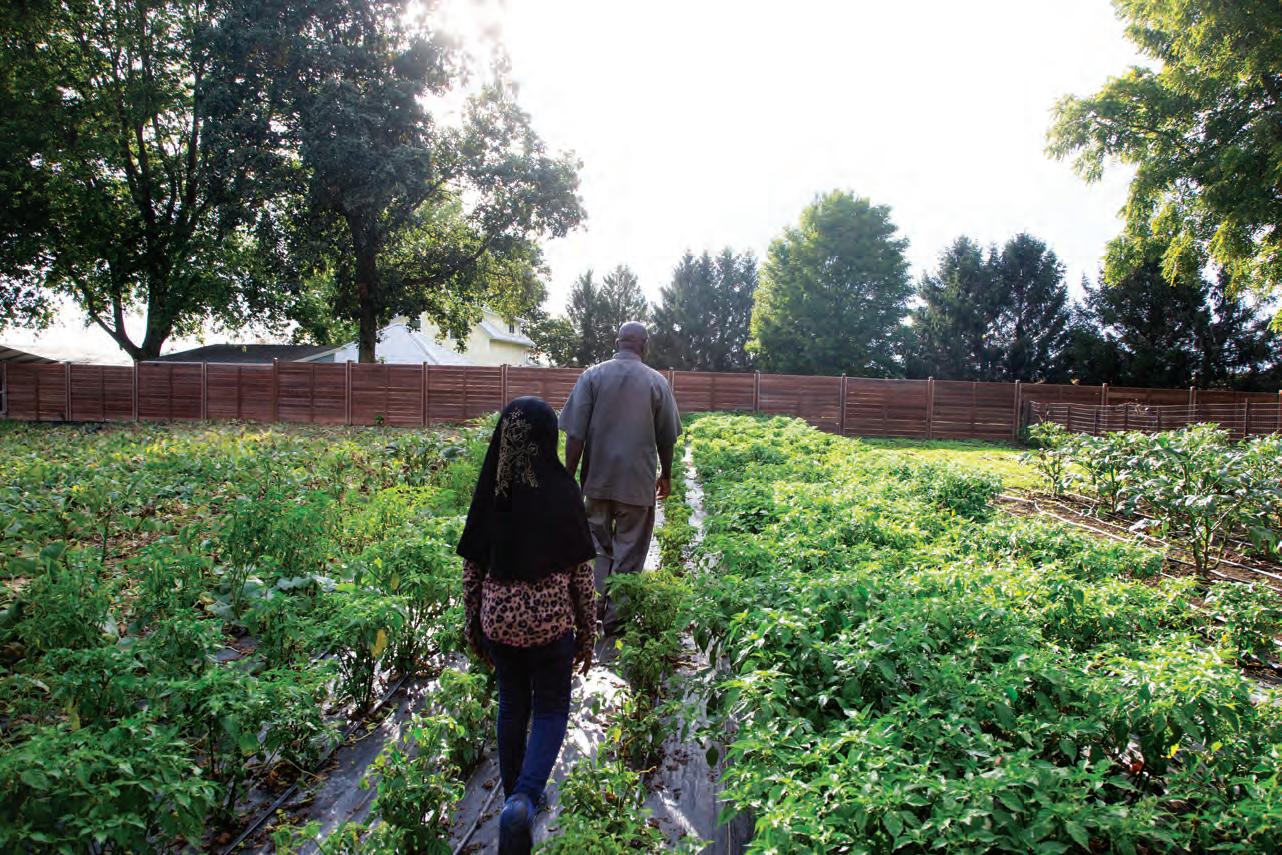
Farm Cycle on Sept. 15. The ride’s gravel segments amounted to a total of seventeen miles. (Beside) Sheep herd together at Black Diamond Meats farm during Farm Cycle. “[Events] like Farm Cycle do so much for our community in bringing awareness to people [on] where their food should come from or does come from,” Kim McWane Friese, former owner of Devotay, an Iowa City restaurant that closed in 2019, said. (Below left) Elsadig Ali walks through his vegetable garden at Black Diamond Meats farm during Farm Cycle. Ali is originally from Sudan and after moving to Egypt, immigrated to the United States in 2005. Ali has been living in Iowa City since 2014. “I feel happy [to host Farm Cycle] because it supports my business,” said Ali. (Below right) Elsadig Ali compares a baby watermelon to one fully grown watermelon at his vegetable garden at Black Diamond Meats farm during the Farm Cycle. (Bottom) Tim Ellsworth and other event participants eat food at Blueyah Blueberry Farm during the Farm Cycle. Ellsworth rides with a group from Grinnell, Iowa. “We love to support the bike library — it’s a great program.” Five years ago, he helped start the Prairie Burn 100, an annual charity gravel ride for the Imagine Grinnell organization, which spearheads various community initiatives in Grinnell.



vs.
How Iowa second-year golfer Noah Kent went from being a hockey player at heart to earning 2025 U.S. Open and Masters exemptions after a performance for the ages.
Chris Meglio Pregame Reporter sports@dailyiowan.com

It wasn’t too long ago when a 14-year-old Noah Kent gave up hockey to focus on golf. Now 19 years old, the Iowa golfer earned an exemption to the 2025 Masters and U.S. Open.
The 6-foot-4 second-year was the 560th-ranked amateur when he arrived in Chaska, Minnesota, for the U.S. Amateur.
Kent put together a performance for the ages before falling to World Amateur No. 10 in Arizona State fourth-year Jose Luis Ballester by two holes in the 36-hole match play final.
Despite the loss, his strong play moved him up to the 294th-ranked amateur and will now have him alongside the very best in the world come 2025.
Hailing from Naples, Florida, Kent grew up a multi-sport athlete, with hockey being his main sport. Golf, however, has always played a pivotal role in his childhood. His father, David Kent, competed in the 1990 U.S. Junior Amateur, and his stepfather, Dana Fry, is a golf course architect.
“My girlfriend and my caddy were the two people that really pumped me up.”
Noah Kent Iowa golfer
Fry has been a notable figure in the golf world beyond his course designs. A member of the ASCGA — the American Society of Golf Course Architects — since 1992, he served on the Board of Governors and was the ASGCA speaker at the Golf Industry Show.
In 2001, he was selected to Golfweek Mag azine’s “40 under 40” list, which includes people in leadership positions within the sport who are expected to shape the business for the foreseeable future.


Because of his stepfather’s success, Kent experienced many moments that most kids wouldn’t get while growing up.
When he was nine years old, he had a chipping contest with six-time PGA Tour winner Rocco Mediate during a casual round with Fry. He also had the opportunity to build relationships with 1993 U.S. Amateur and former
University of Minnesota star hockey player John Harris.
Despite his father’s and stepfather’s golfing backgrounds, Kent never took golf seriously until a conversation with golf icon Rory McIlroy sparked his drive for the sport, after which Kent shifted his full focus away from hockey and toward golf.
“One of my friends grew up playing hockey, and I’m like, ‘Oh, that seems cool — I’ll play it,’ and I fell in love with it,” Kent said. “Then I met a [PGA] tour player, Rory McIlroy, when I was 13 or 14, and I’m like, ‘Yeah, golf seems cooler, so I’m going to play golf.’
Kent attended Gulf Coast High School, where he anchored the team to four top-12 finishes at the state tournament. He was a three-time first team all-conference mem-
ber, one-time second team all-conference member, three-time tournament medalist, one-time district champion, and one-time Southwest Player of the Year.
He also logged the lowest scoring average in school history — a feat he accomplished two years in a row.
Having garnered attention from several Division I schools, Kent committed to play golf at the University of Iowa. His family ties to the Hawkeyes played a part in that decision, and it just so happened to be the first school to offer him.
“So my mom was originally from Iowa, and one of my uncles played football here, so I kind of always grew up watching the Hawks,” Kent said. “And then the coach [Tyler Stith] was the first one to give me an offer … kind of believed in me first.”
In fall of 2023, during Kent’s first run as a Hawkeye, he competed in all four tour-
After a victory over Troy, the Iowa football team gears up for their Big Ten opener against Minnesota.

Brad Schultz
Following a disastrous loss against Iowa State, the Iowa football team responded with a 38-21 home win over Troy on Saturday, improving to 2-1 in the young season.
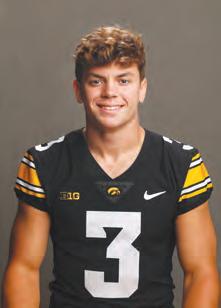
Now, Iowa turns its attention to its Big Ten opener on the road at Minnesota, who enters the contest with an identical 2-1 record after blasting Nevada, 27-0, last weekend. The Gophers have been a respectable Big Ten team under eighth-year head coach P.J. Fleck, but it suffered a disappointing 5-7 campaign in 2023, marking only their second losing season under Fleck. The highlight of Minnesota’s 2023 season was undoubtedly its controversial victory over Iowa at Kinnick Stadium on Oct. 21, where Hawkeye defensive back
between
Cooper DeJean was called for an illegal fair catch on a game-winning punt return touchdown with only seconds left, giving the Gophers the “Floyd of Rosedale” trophy for the first time since 2014. Everyone in Iowa City has waited a whole year to get even, and now the time has come. Due to the hype surrounding this rivalry game, it will be televised in prime time at 6:30 p.m. local time on NBC. In order to digest this matchup, a deeper look at Minnesota is due.

After a dismal offensive showing in 2023, starting quarterback Athan Kaliakmanis transferred to conference rival Rutgers for a fresh start, leaving a big hole for Minnesota to fill.
naments, including a top-25 finish at the ANF Fall Classic. The spring 2024 season saw him take a leap, notching five top-25 finishes and three top 10 finishes in seven spring events, respectively.
His low round of 63 was tied for the second-lowest 18-hole score in school history, and his low score of 202 was the third-lowest 54-hole round in school history. The score of 202 earned him third place at the Puerto Rico Classic.
Now in his second year with the program, Kent earned himself a spot in the U.S. Amateur. He qualified for the U.S. Junior Amateur in 2023, but an ATV accident that occured during the summertime forced him to withdraw. He initially felt embarrassed by the situation, but it ultimately rejuvenated and enhanced his love for golf like never before.
Annika and Rachel Herbine are one of the successful Iowa field hockey sister duos.
Jake Olson Sports Reporter sports@dailyiowan.com
The Iowa field hockey program has had a plethora of sibling duos don the Black and Gold throughout its storied history. Tiffany and Tammy Leister, Missi and Mel Sanders, and Nancy and Katie McLindin are just a few of the dynamic sister pairs over the last three decades.
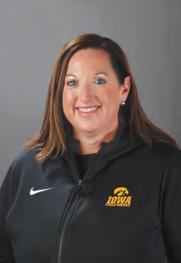
“To be honest, in Iowa field hockey history we have had a ton of sisters that are usually one or two years apart,” Iowa field hockey head coach Lisa Cellucci said. When it comes to recruiting these sibling combinations, Cellucci doesn’t go out of her way to make sure they both get on the team. But after making a connection with the families, it makes it easier to recruit the younger sibling due to the established relationship with the older one.
“When we get to know the families and realize that they have a sister that plays, and if they play in the same club, we always keep our eye on it,” Cellucci said. “It is just a great connection to have. Not that it’s an easier recruit for us to get, but sometimes it could be if their sister has a really good experience.”
This season, the Hawkeyes feature a pair of sisters that have been playing together for most of their careers. Fourth-year forward Annika Herbine and second-year midfielder Rachel Herbine find themselves playing on the same team once again.
“We played together in high school and then on club,” Annika Herbine said. “We just always wanted to go to college together. I committed here first. Rachel was looking at other schools, but I think she knew she wanted to come here.”
Football
Saturday, Sept. 21 Minnesota
6:30 p.m.
The Iowa volleyball team has found real community within the squad.
Jack
Birmingham Sports Reporter sports@dailyiowan.com
The Iowa volleyball program has found a burst of energy with a new team dynamic com bining many new faces with a few key returning players from last year.
The Hawkeyes finished the 2023-24 season on a 20-game losing streak, finishing with a dis mal final record of 8-24.
But Iowa was determined to rebuild and paired inexperienced yet talented athletes, with veteran leadership from the transfer portal and within the program to turn the team around.
The result has been a success so far, as the Hawkeyes are off to a solid 4-1 start with vic tories over Liberty, Providence, Delaware, and Cal Baptist.
3

Caitlin Clark has been on fire during the second half of the WNBA season, refusing to stall after a lengthy break for the Olympics in August.
Clark recently added to her historic rookie resume yet again by earning Player of the Month honors for August, in which she averaged 24 points, 8.5 assists, and 5.2 rebounds in six games.
After becoming the first rookie in WNBA history to record a triple-double, she doubled down and did it again on Sept. 4, beating the Los Angeles Sparks en route to 24 points, 10 rebounds, and 10 assists as she shot 8-of-17 from the field and snagged three steals.
That’s her second of the season, becoming just the fifth player in WNBA history to log multiple in a single year — joining Alyssa Thomas, Courtney Williams, Sabrina Ionescu, and Candace Parker. Before that, Clark set the WNBA single-game record with 19 assists and currently sits first in the league in assists with 8.4 per game, comfortably over Thomas with 7.8 and Natasha Cloud with 6.7. She’s also leading the league in three-pointers made per game with three, tied with Arike Ogunbowale and just above Ionescu at 2.9. These are some of the best shooters in the world, and Clark stands among them all. The Fever have already clinched a playoff spot in a year that looked like a rebuild.
Third-year Head Coach Jim Barnes credits his squad for helping the program grow in the rugged Big Ten.
“We’re a very new group, and a lot of people put their trust in coming here and helping build this program,” Barnes said. “I just love building a team and helping them learn how to work to gether, pull together, and make each other bet ter.”
One player that has been a crucial piece of the rebuild is fourth-year Gracie Gibson, a transfer from Lafayette. Gibson started all 24 matches for the Leopards in 2023-24, logging 156 kills and 85 blocks.

Hailing from San Antonio, Texas, Gibson knows that the team’s support for one another is a key part of their success.
“I think everyone supports each other just about more than any team I’ve ever been on,” Gibson said. “Whether we’re winning, losing,
“Whether we’re winning, losing, practice, games, no matter what it is, I know that there’s always a ton of people on the team that can lift you up no matter what’s going on. Everyone’s super positive.”
Gracie Gibson Transfer from Lafayette
practice, games, no matter what it is, I know that there’s always a ton of people on the team that can lift you up no matter what’s going on.
Everyone’s super positive.”
Gibson and the other transfers are only a portion of the team’s new additions, as the Hawkeyes added nine freshmen to the roster. First-year Jaimie Marquardt loves how the team always has each other’s backs.
“We’re always supporting each other,” Marquardt said. “If someone messes up on the court, I have trust in them that they’re going to get the next ball. I think trusting each other and having that good team chemistry is something that we’ve been doing.”
Barnes interprets much of the team’s success as a result of its hard work and unique players, including third-year setter Claire Ammeraal who recently crossed the historic threshold of 2,000 career assists during a win over Providence on Aug. 31.
“We play with a lot of effort, and we’ve got an unorthodox team with a setter that can be so offensive,” Barnes said. “We’re able to do some things other teams don’t normally see. We’ve
Trey Benson Sports Reporter sports@dailyiowan.com
The Daily Iowan: When did you first start playing goalkeeper?
Macy Enneking: I first started in goal when I was around four years old. I always loved the position because I felt you could be a hero. I was a forward for my high school team but played goalkeeper during my club season. I loved being a forward, but I knew being a goalkeeper was my purpose with the sport.
What does a typical day of training look like?
We train in the mornings usually around 8 a.m., so I usually wake up around 5:30 a.m. and eat breakfast and get ready. I then head to the athletic training room. Recently, the goalkeepers have been using a VR headset to work on reaction time, so we will occasionally do that before training as well.

“We expect [McNamara] to be our quarterback... He’s still working his way back into shape, as is our whole team with the offense and whatever. But we’ll get better. We’ll improve. Our guys have a great attitude, he’s got a great attitude, and we’ll work through this.”
Iowa football head coach Kirk Ferentz on starting quarterback Cade McNamara
passing yards McNamara threw for against Troy on Sept. 14
It’s unfortunate that we have to have this discussion so early in the season, but after seeing Cade McNamara’s first three games, Brendan Sullivan deserves a chance to prove himself as the starting quarterback.
McNamara was outstanding in the second half against Illinois State after a shaky first half, but he couldn’t carry his performance into the Cy-Hawk game, throwing for only 99 yards and two interceptions.
Though one of the picks came on the game’s final play, McNamara’s first interception of the contest completely changed the direction of the game. The Hawkeyes were leading, 13-0, with the ball at Iowa State’s 40-yard line, but McNamara forced a pass into heavy coverage on first down, giving the ball right back to the Cyclones.
Iowa State responded by driving straight down the field for a touchdown to cut the lead down to six, and the game turned from there.
Most practices, the goalkeepers go off and do our own training while the team is warming up or doing drills that do not require us. Toward the end, we go back with the team and do drills that put us in more game scenarios.
got some leverage there. We just [have] to be more consistent.”
Gibson, who tallied seven kills in the Puerto Rico Clasico, agrees that the team can get better by working on its consistency.
“We have some highs and lows right now,” Gibson said. “I think we can get a little bit more consistent and keep the highest level that we can play at throughout the game. I think our energy right now is good. We have a lot of people on the bench that are super supportive and always bring all the energy, which translates to the court.”
Marquardt enjoys learning from the more experienced members of the team while also contributing big plays.
“They have a ton of experience,” Marquardt said. “We have a young team, so just being able to learn from the older players and their experience coming into collegiate volleyball is a super valuable thing for us.”

You’ve only allowed two goals all season, putting you 22nd in the nation for goals against allowed. Was this something you envisioned earlier in the season?
I don’t think I thought of this exact goal when envisioning this season, but it certainly was something that I wanted to expect of myself and my team. I know that this team has the ability to be one of the best defensive teams in the country, and I think that title goes along with this determination we have to be hardworking and gritty.
How do you continue to stay focused throughout the 90-minute game?
I try to always be communicating and connected to my backline throughout the
Now, I understand that Sullivan transferred into the program just a few months ago, but his mobility and throwing accuracy is some thing that Iowa desperately needs if it still wants to make a run to the College Football Playoff.
However, considering how Iowa looked against Troy, that might still be up in the air.
entire game. Whether I am getting a ton of action on the net or not, I always make sure that my team knows I am back there so that when the time comes that they need me, I am
How does it feel to win back-to-back Big Ten Goalkeeper of the Week honors?
I am very grateful that our team’s defensive prowess is getting recognition. I wish that I could give the honors to my backline because they make it a running joke that they do not want me to see any shots in a game.
How has being at the University of Iowa helped shape your soccer career?
I think being at the University of Iowa has been the best experience of my life. They have perfectly fit what program I wanted to be a part of. They value hard work and investment over talent, and I think that being a part of a team that trusts each other and pushes each other so much has made me into the woman I am.

Sullivan also has some solid tape on film from his final season at Northwestern, including a stellar showing against Maryland where he threw for 265 yards and two touchdowns.
McNamara did have talent and veteran experience to be a solid starting quarterback in this league, but his inconsistent play has consistently hampered the Hawkeyes in crucial games.
Prior to facing Iowa, Troy was 0-2 and got blasted by 21 points last weekend with a young, inexperienced roster. The Hawkeyes may not have played to their full potential against Troy — considering the 10-14 score with Iowa down at halftime — but if they are able to blow out the Minnesota Gophers, Sullivan absolutely needs to see plenty of snaps in the second half. Maybe Sullivan isn’t the answer after all, but you brought the guy in for a reason. Iowa needs to maximize his skills and give its hungry fanbase a sliver of hope before it’s too late.
A quarterback threw 21-of-31 for 251 yards, three touchdowns, no interceptions, and no sacks in a 40-0 win. Tell me — is that a starting quarterback to you?
Those are Iowa quarterback Cade McNamara’s stats in the seasonopener against Illinois State on Aug. 31. You don’t bench a guy who did that last week. And yes, I’m not ignorant. I know McNamara struggled against Iowa State the next weekend, making the wrong reads or missing them entirely. But it’s barely September, and everyone is panicking about the quarterback situation. This always happens. Fans look to the extreme when things go poorly. They were calling for the firing of head coach Kirk Ferentz last season — in which Iowa won 10 games with an atrocious offense.
However, don’t trick yourself into thinking this team has a shot in the College Football Playoff. Those hopes have been dashed with the Iowa State loss. The schedule is too easy to make any serious movement happen.
Back to my point: In the first game, the second half proved this offense can really produce when things click. And, with all due respect, it’s not like McNamara is a Brock Purdy, blessed with some of the top national receivers. That was McNamara himself who made that happen against the Redbirds. Maybe it is Ferentz’s fault. When he was suspended against Illinois State, acting head coach Seth Wallace evidently gave offensive coordinator Tim Lester a heck of a lot of leeway. When Ferentz was back, the offense stalled like it did last year. In logical reasoning, we call that “no cause, no effect.” Either way, transfer quarterback Brendan Sullivan should not get the nod until this offense really looks dire. Last year? No question — I’d have thrown him in there in a heartbeat. This year? Not yet.
McNamara is a Big Ten Champion. He’s led great teams on the biggest of stages. Healthy and comfortable, he proved two weeks ago he’s a threat.
Let’s not forget, although McNamara is mainly responsible for the Iowa State loss everyone is still dwelling on, the Iowa defense gave up some serious lapses at the end of that game that were equally as costly. It’s a team game. Just because McNamara is the most visible doesn’t mean he’s the problem. Yet.
KENT from 1B
“It’s all up here in my heart,” Kent told Golf Digest. “I have way more competitiveness. I feel like I have a lot more belief in myself, and I have a lot more drive to get where I want to go. I just feel like I want it a lot more than I used to.”
After a T32 finish in stroke play at -1, Kent secured a 4 and 2 Round of 64 win over Chi-
na’s Xihuan Chang; a 2 and 1 Round of 32 win over Ole Miss’ Tom Fischer; a 4 and 2 Round of 16 win over Tennessee’s Garrett Engle; a 3 and 2 quarterfinal win over Cal’s Ethan Fang; and a 2-up semifinal win over Illinois’ Jackson Buchanan before falling short of the title. He was a heavy underdog, not being ranked in the top 500 of world amateurs, but through the support of his loved ones, he found the confidence to defy the odds.

“My girlfriend and my caddy were the two people that really pumped me up,” Kent said. “They kept telling me, ‘You can do it. All it’s going to take is one good round.’ And I got out there and shot 64, so it was pretty cool.”
Thanks to Kent’s swing coach, Claude Harmon III, Kent has plans to play a couple of practice rounds with some of Harmon’s other clients and established tour players such as McIlroy, Dustin Johnson, Zach Johnson, and Brooks Koepka. So despite the U.S. Amateur loss, Kent’s name now holds weight in the golf world as one of the best young golfers in the world. And there’s no other university he’d rather be representing than the University of Iowa. “This is just a place that is really homey, brings you in, and loves you,” Kent said. “It’s a school that I know I can grow at, a school that believes in me.”
ing the football, they make up for it with a powerful rushing attack led by former Oklahoma running back Marcus Major. Through the course of three games, the fourth-year has racked up 85 yards and two touchdowns despite a small workload against Rhode Island.

Another name to watch out for in the Gopher backfield is second-year Darius Taylor, who racked up 124 yards on 11 rushing attempts in the Nevada game. Taylor is also a solid receiving back, catching five passes for 37 yards last weekend.
The receiving corps has produced a fairly balanced attack so far, with Daniel Jackson, Elijah Spencer, and Le’Meke Brockington each collecting over 50 yards receiving through three games.
To fill this void, Fleck recruited New Hampshire quarterback Max Brosmer. He threw for over 3,400 yards and 29 touchdowns during his senior season with the Wildcats, albeit at the Football Championship Subdivision level.
While playing together in high school, the sisters’ competitiveness and passion formed a classic sibling rivalry on the field.
“I will admit that maybe sometimes we are physical with each other at practice because we know we can be,” Rachel Herbine said. “We know we won’t be mad at each other after, but we definitely have a go at each other. You know, it happens, it’s physical, but we are sisters, so we just brush it off.”
Cellucci and her coaching staff have witnessed several of the friendly competitions between both sisters on and off the field.
“Sometimes the coaches and I just have to sit back and chuckle a little bit,” Cellucci said. “They are very different people, too. Rachel is very competitive and very feisty, and Annie will just get her little digs in when she can. Especially with them playing two different posi -
Brosmer struggled in the season-open ing loss against North Carolina but recaptured his confidence the follow ing week during a 48-0 win over Rhode Island, tallying 271 yards and two touch downs. It was a mixed result against Nevada as Brosmer tossed just one touch down but also threw an interception. While Minnesota may struggle throw
tions, they battle with each other a lot. But they keep it clean and always come back together at the end.”

After playing with each other for so many years, both sisters have developed a special chemistry, learning both of each other’s playing style and pace of play.
“Playing with her from a young age, I definitely know where she is going to be positionally on the field,” Rachel Herbine said. “Especially from watching her and playing in club and high school. I feel like we connect very well on the field.”
The Herbine sisters said having a sibling on the team is great for many reasons, but the most important ones are the constant praise they give each other, being each other’s biggest fans, and giving out the confidence that is needed to keep going.
“I am definitely her biggest supporter, and I know she is mine,” Rachel Herbine said. “We are very proud of each other in all of our accomplishments. We just push each other to be the best we can be at practice.”




The Gophers have been a solid defensive unit to begin the season, allowing only 6.3 points per game through three games, including shutouts against Rhode Island and Nevada. Additionally, Minnesota has collected seven sacks, seven interceptions, and 172 tack-
The results have pleased new Defensive Coordinator Corey Hetherman, who came to Minnesota in the offseason after serving two seasons as linebackers coach for Rut -
gers. Hetherman brings what he calls “a super aggressive” style of defense that features heavy blitzing. The Hawkeyes are known for their predictable style on offense, but the Gophers’ aggressive style of defense could potentially open up holes for star running back Kaleb Johnson.

Minnesota’s special teams gained a big plus when reigning Big Ten Bakken-Andersen Kicker of the Year Dragan Kesich returned for his final season. Despite his popularity, Kesich has failed to carry over the momentum in 2024, making only five of his nine field goal attempts. Kesich missed two field goals in the season-opener against North Carolina, including the game winner in the final seconds.
Mark Crawford is in his fifth season as the starting punter, averaging 44.7 yards on nine attempts.
This may be the most intriguing Floyd of Rosedale game in years, considering what took place just a season ago. These two teams clearly don’t like each other, and I expect a classic, hard-nosed Big Ten football game in Minneapolis.





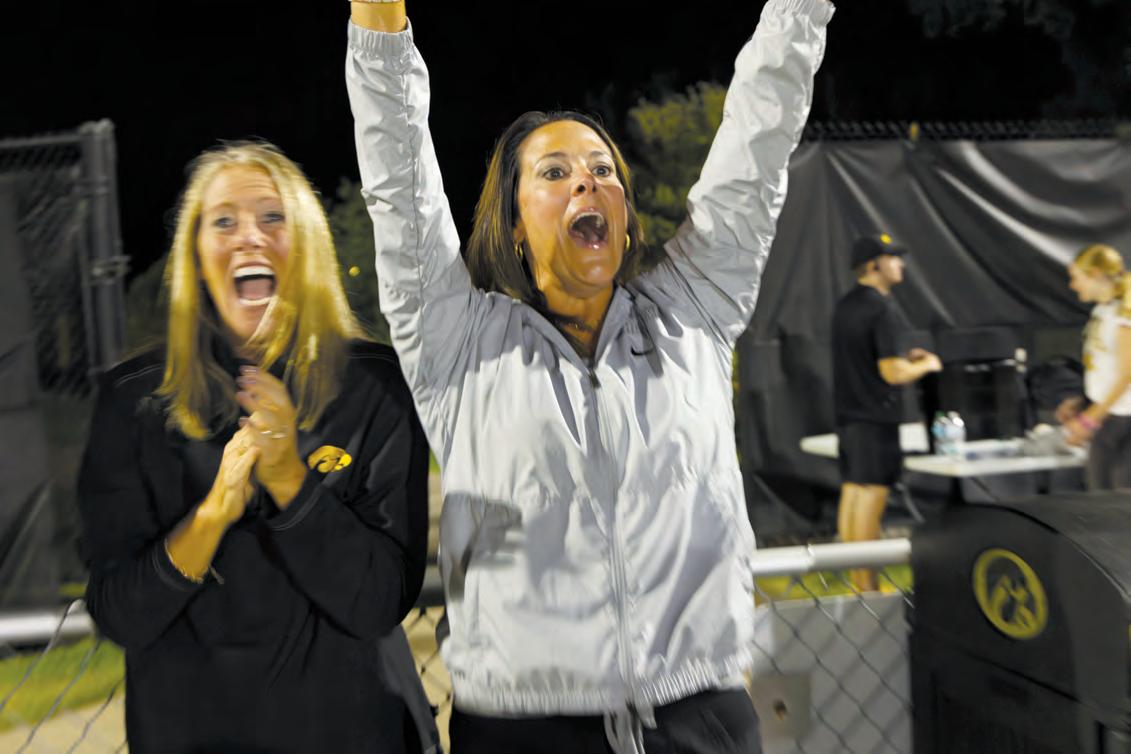

Vinyl records, toys, clothes, and all things retro are back in demand among Iowa City’s young, college-aged shoppers.


ARTS & CULTURE | WEDNESDAY, SEPTEMBER 18, 2024
Fidel Cardoso, a bartender at The Green House cocktail lounge, shares the recipe for a rum-based signature drink.
Stella Shipman Managing Editor stella.shipman@dailyiowan.com
Customers walking through the front doors of The Green House cocktail bar and lounge are immediately greeted by an emerald sea of potted, standing, and dangling plants. Warm, yellow light bounces off floor-to-ceiling windows, and a long bar displays flowery drinks.

Opened in September 2022 by University of Iowa alum Emily Salmonsen, The Green House is an oasis that encourages customers to “enjoy a moment of zen” in a comfortable lounge area or on the outdoor patio, according to the bar’s website.
“It’s just a place where you can come with friends and sit and chat,”
Fidel Cardoso, bartender at The Green House, said.
Cardoso has been bartending at The Green House during his gap year from the UI. Even though he has

Waterhouse solidifies her songstress status with her second album, ‘Memoir of a Sparklemuffin.’ REVIEW
Emma Isenhart Arts Reporter arts@dailyiowan.com
Whether it’s selling out venues or starring in major TV shows like “Daisy Jones and the Six,” Suki Waterhouse has done it all. Her particular brand of indie pop has solidified her as an artist to keep an eye on, and her new album, “Memoir of a Sparklemuffin,” proves why. Through a whopping 18-song tracklist, Waterhouse continues to carve out her own space in the indie/dreampop genre, penning masterful lyrics along the way.
Named after the jumping Australian Peacock Spider, Waterhouse’s album’s ridiculous titlr is a metaphor for herself. She fully jumps into the colorful, off-center world created with these songs, pulling no punches in this sparkling sophomore album. The album cover only adds to the ambience of this world, depicting Waterhouse perched in a white beaded dress below the album name shimmering in the evening sky.
The album opens with “Gateway Drug,” a powerful track complete with rock undertones and strong drumbeats. Waterhouse’s angelic vocals call out to an unknown person, coaxing them back into love, begging to be their “gateway drug.” Immediately after, Waterhouse transfers into an echoey self-care ballad called “Supersad.” Giving a huge middle finger to the world, she sings, “I look so much better when I don’t care!” This isn’t the only track where Waterhouse voices her frustration about caring too much. “Nonchalant” also dives into the world of a “quintessential cool girl” who couldn’t care less about those around her.
Many other songs on the album pertain to her positive love life, such as “Lullaby” and “To Love.” Waterhouse has been dating actor Robert Pattinson since 2018, and they welcomed their first child together in March. The couple’s hap -
worked at other Iowa City establishments, Cardoso said The Green House is the first bar where he has been able to practice making more classic cocktails.
Cardoso shared his process of making a signature cocktail called the Audrey, which began with placing several fresh blackberries in the bottom of a glass mug, along with leaves of mint grown right outside the building.
After pouring lavender simple syrup
“It’s
just a place where you can come with friends and sit and chat.”
Fidel Cardoso A bartender at The Green House
and a couple ounces of fresh lemon juice into a mug, Cardoso muddled the ingredients together. He added Don Q Cristal, a smooth, white rum, to the mixture. The final ingredients of the drink were seltzer and ice. Cardoso topped off the purple ombré of a mug with a slice of lime and a sprig of mint.
The Audrey is a refreshing botanical drink, especially on a hot summer day. Each sip through one of the bar’s agave straws is sweet with a hint of rum and blackberry
seeds, ending with a tart bite from the lemon, lime, and seltzer. The notes of lavender enhance the drink’s fruity flavor and the bar’s roots in greenery.
The Green House also has a rich selection of mocktails and nonalcoholic drinks, and the Audrey is no exception. With the simple removal of rum as an ingredient, it becomes a mocktail that is just as delicious and attractive.
When it comes to food, customers are welcome to bring their own snacks or order one of The Green Houses’ small plates. In addition, the bar’s website encourages customers to stop by the New Pioneer Food Co-op across across the street, a local and sustainable grocery market.
Along with posting aesthetic drinks and pictures of the bar’s interior on social media, The Green House has been advertising drink deals for pumpkin-spiced coffee beverages, hoping to introduce customers to the bar through more traditional fall favorites. Autumn will also bring a new menu of drinks to the bar, but its signature cocktails will be sticking around.
piness is evident in these songs, with the lyrics reading like a love letter to Pattinson and their daughter.
Even with a loving fiancé and a newborn, a few songs on this album will surely end up on “Female Rage” playlists. “OMG” and “Lawsuit” lead the pack, the former being a prime candidate for screaming in the car down the interstate. Waterhouse screams, “Take me back to the way that I was!” wishing for her life before she met her man.
“Lawsuit” is even gutsier. Waterhouse digs at a guy her friends have been gossiping about in a breezy, whimsical tone. She wishes this man luck with his lawsuit, an inevitable twist of fate rightly deserved.
My favorite song on the album is undoubtedly “Blackout Drunk.” The punchy tune chronicles the all-too-familiar tale of dealing with a drunken mess of a boyfriend. Waterhouse “can hardly wait to tell you all the shitty things that you’ve done” once her partner wakes up in the morning. The upbeat, energetic tempo juxtaposes the depressing lyrics wonderfully, creating a beautiful contrast within the song. By the end, Waterhouse has led the listener down a winding path of her feelings, all backed with soft guitar strums and high hats. Akin to the sensation of going around one too many times on a carousel, the lengthy 18-track album may leave some feeling lost, but it ultimately ties up nicely.
Regardless of anyone’s opinion on this genre of music or the length of the album, one thing is certain: Suki Waterhouse has made her mark in the music industry and is here to stay.
Charlie Hickman Arts Editor charlie.hickman@dailyiowan.com
Reece A. Caven is a senior at the University of Iowa studying creative writing. Caven decided he wanted to pursue writing while attending basic training in the National Guard during his enrollment. Throughout his semesters at the UI, Caven chipped away at a passion project that became his debut fantasy epic novel, “The Liar and the Knight.” The book was independently published through IngramSpark and is now available on Amazon.
This interview has been edited for length and clarification.
The Daily Iowan: Did growing up in Iowa City influence your choice to pursue writing?
Caven: Being in Iowa City cemented my decision to be a creative writing major for sure, but it wasn’t something I thought about when I was a kid. It was a happy coincidence that I grew up in Iowa City all my life, and only after I decided I wanted to be a writer did I find out that this is the place to do it.
How did your creative writing workshop classes help shape the novel?
I workshopped the first chapter in class, and then I worked pretty closely with my teachers on a couple of other chapters throughout writing. School helped me a lot with it. The workshop really helped with the action scenes, particularly. I gauged how they were reading, if they made sense, if they were easy to follow, whether or not the main character was likable.



Cardoso hopes The Green House continues to keep the ball rolling in sales and good attention from customers with its welcoming atmosphere and flavorful concoctions. “You’re going to get a good drink, have a relaxing time, and make some friends,” Cardoso said.
Without the workshop, I’m just sort of guessing. I might think the action scenes are fun and easy to follow, but the feedback from other people hones those aspects. I hired a professional editor on Reedsy. My editor was the person who told me to rewrite my first chapter and bring it to the workshop. I had the whole manuscript ready and then tweaked it through feedback in school. Do you find it easy to take feedback, whether it be from students or editors? Maybe it’s a self-confidence thing, but I always assume everyone else is right about my writing. That has been a problem in the past in workshops, but I learned I need to trust myself more. I needed to be willing to say, ‘I’m right about this for this piece.’ I’m good at taking feedback, but now it’s about deciding whose feedback I trust the most. If I hear five people say an action sequence doesn’t work, I’ll listen to them.
The class determines it, too. Sometimes, if there’s someone in the class whose writing I like, I will be more inclined to listen to their advice. Not because I don’t respect the other writers, but because I like this person’s writing so much and want to write like them. There was a super detailed paragraph in my book that I fought for after my editor said I should take it out. It was too long and descriptive, but I liked it a lot, so I kept it.
Read more online
See more of The Daily Iowan’s interview with Caven at dailyiowan.com.

nostalgia trending among youth, Iowa City businesses are embracing the past.
Emma Isenhart
Arts Reporter
Flynn Milligan
Arts Reporter
With AI technology running rampant and people increasingly glued to their phones, Gen Z is becoming nostalgic for the past.
Polaroid cameras, vinyl records, and used clothing have been flying off the shelves. Despite this generation being the most tech-dependent alive, social influences have pushed young people to gravitate toward the old rather than the new.
Iowa City is a prominent college town, and investing in nostalgic memorabilia is a lucrative venture. Many businesses advertise to the college demographic, emphasizing vintage items including clothes and other collectibles.
One such business is Record Collector, a record shop downtown Iowa City that carries both vintage and contemporary vinyls, CDs, and other forms of physical music media.
“More students are realizing that the same things that made vinyl cherished by our parents’ generation are the same things we crave,” Oscar Rodriguez, a University of Iowa graduate student working at Record Collector, said. “Having something physical that we associate good memories with is something that students are relating to right now.”
The tangible reminder of a good memory is more emotionally effective than pixels on a screen. Placing a record on the turntable, setting the needle down, and hearing the surface noise beneath the music creates a more immersive experience than clicking through Spotify.
“Chappell Roan’s record — we’ve been trying to keep it in stock for months and months, but every time we get it, we sell out of it. We just sold two copies today,” Rodriguez said. “On top of that, we sell a lot of ‘60s and ‘70s stuff students’ parents would listen to. The Talking Heads, Blondie, Bee Gees, you name it.”
A concept as ambiguous as nostalgia is hard to physically quantify and describe. Bartertown Toys and Collectibles at the Old Capitol Mall, however, does just that.
Jeremy Ziegenhorn opened the store three years ago and has always been interested in the world of memorabilia, trading items with his friends as a child.
“I had been doing conventions for many years before [opening the store], and then before that I’d just been a huge collector since I was a little kid,” Ziegenhorn said.
Nostalgia has always been popular, but the idea has begun to increasingly surface as more people long for their favorite memories of the past. As the distance between the present and a fond memory increases, the desire to recapture that good feeling only grows stronger.
“Nostalgia has always been there. It’s a human condition. As we get older, we long for those days gone and a lot of these things just click that memory of way back when — the good times, and things like that,” Ziegenhorn said.
Bartertown is filled wall-to-wall with collectibles from all different decades and genres. Walking around the store is like touring multiple eras at once. From comic books and action figures to old electronics and movies, Ziegenhorn spends his days in what could be described as a nostalgia wonderland.
“For me, it’s the action figures from the ‘80s, which was the golden age of toys, so that’s my bread and butter because I was born in ‘81. I always tell people, ‘If I win the lottery, I’m building Castle GraySkull,’ Ziegenhorn said, referencing a fictional castle from the popular animation He-Man and the Masters of the Universe. “I will live in that sucker.”

The store has become a hotspot for collectors in Iowa City. It draws in not just university and high school students but people of all ages and hobbies. Ziegerhorn said he is eager to expand upon the success the store has already seen.
With a massive collection of items, it can be difficult for Ziegenhorn to choose what is displayed in his modestly sized store.
“There’s hot things like video games we’ll put out right away. I’ve bought massive collections of different things, especially these last three years, so then I don’t have room for it,” Ziegenhorn said.
“Having something physical that we associate good memories with is something that students are relating to right now.”
Oscar Rodriguez Employee at Record Collector
Living and working in a college town, Ziegenhorn gets to meet and speak with people from around the world and many different generations. This is an opportunity he cherishes deeply.
“It’s crazy because the college kids come and they’re blown away by [the store] and their parents come with them and they’re blown away by it, so it transcends all age groups,” Ziegenhorn said. Along with records and collectibles, thrifting has become a
major trend among Gen Z. Ragstock, a leader in selling vintage clothing, can’t keep their recycled items in stock.
“Vintage is such a hodge-podge of random stuff. You’ll end up finding something so specific to you when you go vintage shopping, whereas if you’re shopping at a chain retail store, a lot of times it’s much harder to find unique pieces,” Tristan Farmer, a UI graduate and Ragstock employee, said.
In an age where a simple internet search leads to virtually any article of clothing, sifting through a pile of vintage clothes may seem like a lost cause. However, Farmer theorized students enjoy thrifting more than the easier internet route because of the gratification.
Spending time searching through hundreds of thrifted items gives way to a sensation of accomplishment when a good find is discovered. Information is constantly accessible thanks to the dawn of the internet but finding something special in a bin of old clothes takes a certain level of dedication. It’s not as simple and impersonal as typing a word into a search bar.
There are other reasons to shop secondhand. With prices rising everywhere, thrifting allows students to buy items without breaking the bank.
The moral and environmental aspects of thrifting also play into the popularity of nostalgia.
Shein, a popular fashion site, sells clothes for low prices, leading to overconsumption. Many of their low-quality products end up directly in landfills.
“You don’t want to buy from Shein, but Shein is the most affordable thing right now,” Farmer said. “Most college kids don’t have the money to pay for new stuff, so I can go thrifting and get it secondhand, and then I’m not supporting these awful businesses.”


Edited by Will Shortz No. 0814





